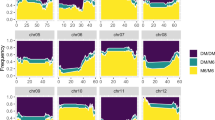Abstract
The restoration of male fertility in the sorghum IS1112 C (A3) male-sterile cytoplasm is through a two-gene gametophytic system involving complementary action of the restoring alleles Rf3 and Rf4. To develop markers suitable for mapping rf4, AFLP technology was applied to bulks of sterile and fertile individuals from a segregating BC3F1 population. Three AFLP markers linked to rf4 were identified and subsequently converted to STS/CAPS markers, two of which are co-dominant. Based on a population of 378 BC1F1 individuals, two STS/CAPS markers, LW7 and LW8, mapped to within 5.31 and 3.18 cM, respectively, of rf4, while an STS marker, LW9, was positioned 0.79 cM on the flanking side of rf4. Markers LW8 and LW9 were used to screen sorghum BAC libraries to identify the genomic region encoding rf4. A series of BAC clones shown to represent a genomic region of linkage group E were identified by the rf4-linked markers. A contig of BAC clones flanking the LW9 marker represent seed clones on linkage group E, from which fine mapping of the rf4 locus and chromosome walking can be initiated.
Similar content being viewed by others
Author information
Authors and Affiliations
Additional information
Received: 20 June 2001 / Accepted: 3 August 2001
Rights and permissions
About this article
Cite this article
Wen, L., Tang, H., Chen, W. et al. Development and mapping of AFLP markers linked to the sorghum fertility restorer gene rf4 . Theor Appl Genet 104, 577–585 (2002). https://doi.org/10.1007/s00122-001-0774-3
Issue Date:
DOI: https://doi.org/10.1007/s00122-001-0774-3




